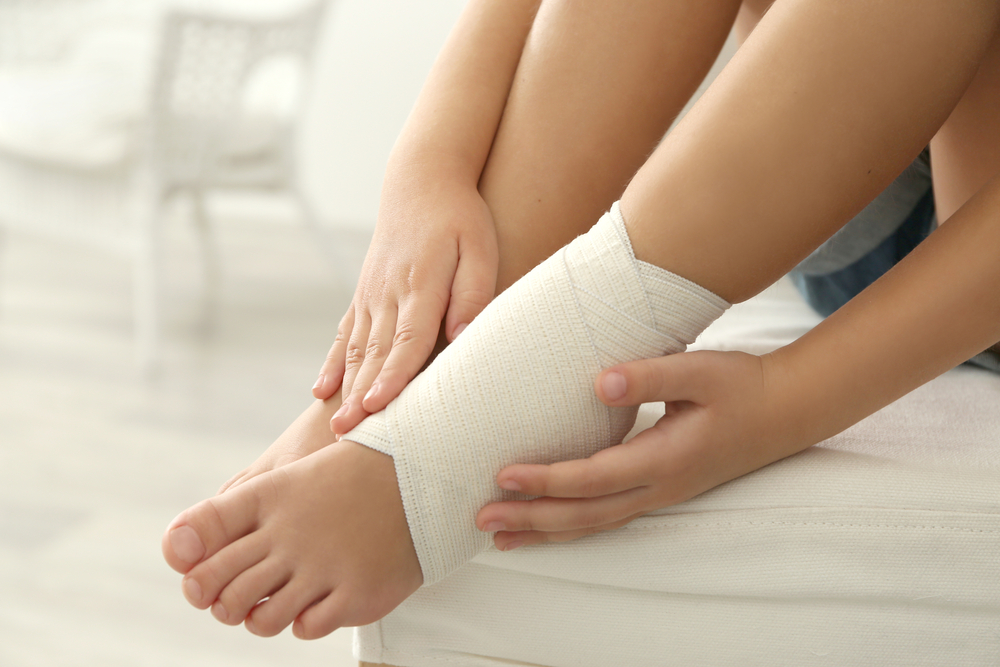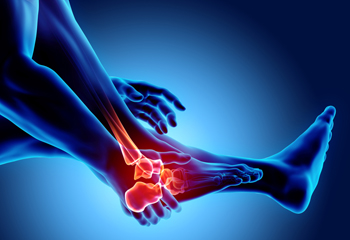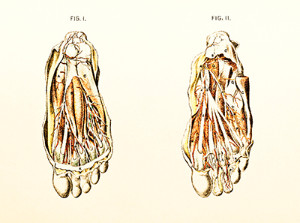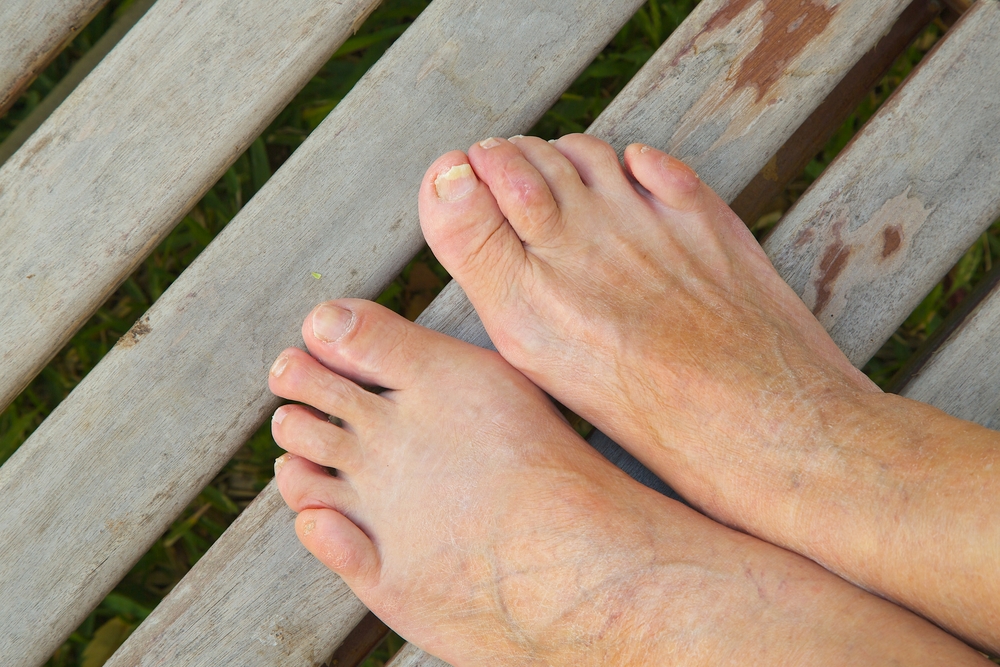Items filtered by date: December 2020
Mild Relief of Ankle Sprains
 An ankle sprain is a common cause of ankle pain. It generally occurs as a result of turning or rolling the ankle beyond its normal range of motion. This can happen from stepping off of a curb unexpectedly, which may cause the ligaments of the ankle to become overstretched or torn. The grades of ankle sprains can vary and each grade plays a role in the length of recovery time. Relief may be found when simple stretches are performed, and this may accelerate the process of healing the ankle joints. Additionally, it may help to strengthen the muscles surrounding the affected area in order to help avoid re-injury. Other ways to find relief may include manual therapy or staying off of the affected ankle as often as possible. If you are experiencing any type of ankle pain it is strongly suggested that you confer with a podiatrist who can determine what the best course of treatment is for you.
An ankle sprain is a common cause of ankle pain. It generally occurs as a result of turning or rolling the ankle beyond its normal range of motion. This can happen from stepping off of a curb unexpectedly, which may cause the ligaments of the ankle to become overstretched or torn. The grades of ankle sprains can vary and each grade plays a role in the length of recovery time. Relief may be found when simple stretches are performed, and this may accelerate the process of healing the ankle joints. Additionally, it may help to strengthen the muscles surrounding the affected area in order to help avoid re-injury. Other ways to find relief may include manual therapy or staying off of the affected ankle as often as possible. If you are experiencing any type of ankle pain it is strongly suggested that you confer with a podiatrist who can determine what the best course of treatment is for you.
Ankle sprains are common but need immediate attention. If you need your feet checked, contact Dr. Douglas Mckay from New Jersey . Our doctor can provide the care you need to keep you pain-free and on your feet.
How Does an Ankle Sprain Occur?
Ankle sprains take place when the ligaments in your ankle are torn or stretched beyond their limits. There are multiple ways that the ankle can become injured, including twisting or rolling over onto your ankle, putting undue stress on it, or causing trauma to the ankle itself.
What Are the Symptoms?
- Mild to moderate bruising
- Limited mobility
- Swelling
- Discoloration of the skin (depending on severity)
Preventing a Sprain
- Wearing appropriate shoes for the occasion
- Stretching before exercises and sports
- Knowing your limits
Treatment of a Sprain
Treatment of a sprain depends on the severity. Many times, people are told to rest and remain off their feet completely, while others are given an air cast. If the sprain is very severe, surgery may be required.
If you have suffered an ankle sprain previously, you may want to consider additional support such as a brace and regular exercises to strengthen the ankle.
If you have any questions please feel free to contact one of our offices located in Caldwell, and Galloway, NJ . We offer the newest diagnostic and treatment technologies for all your foot and ankle needs.
Precautions to Prevent Fungal Nails
Toenail fungus is the result of an infection underneath the surface of the toenail. This infection can cause symptoms such as the nail becoming thickened, crumbly, and discolored. The infected nail may also develop a foul smell, cause pain while walking, and can easily spread the infection to other nails. Fortunately, toenail fungus can be prevented. It is important to practice good foot hygiene to prevent infections. Toenail fungus thrives in warm and moist environments. Keep your feet clean and dry and wear breathable shoes and moisture-wicking socks to create a less hospitable environment for the fungus on your feet. When walking in wet, moist public areas where toenail fungus can spread, such as swimming pools and locker rooms, always wear shower shoes. You can also prevent the spread of infection by not sharing personal items like shoes, socks, and towels with others. If you suspect that you may have a fungal nail infection, it is suggested that you see a podiatrist for treatment.
For more information about treatment, contact Dr. Douglas Mckay of New Jersey . Our doctor can provide the care you need to keep you pain-free and on your feet.
Toenail Fungus Treatment
Toenail fungus is a condition that affects many people and can be especially hard to get rid of. Fortunately, there are several methods to go about treating and avoiding it.
Antifungals & Deterrence
Oral antifungal medicine has been shown to be effective in many cases. It is important to consult with a podiatrist to determine the proper regiment for you, or potentially explore other options.
Applying foot powder on the feet and shoes helps keep the feet free of moisture and sweat.
Sandals or open toed shoes – Wearing these will allow air movement and help keep feet dry. They also expose your feet to light, which fungus cannot tolerate. Socks with moisture wicking material also help as well.
If you have any questions please feel free to contact one of our offices located in Caldwell, and Galloway, NJ . We offer the newest diagnostic tools and technology to treat your foot and ankle needs.
What Are the Early Symptoms of Rheumatoid Arthritis?
 Rheumatoid arthritis (RA) is an autoimmune condition that causes the body’s immune system to attack its own healthy tissue, including the lining of joints. This leads to initial symptoms such as joint pain, swelling, stiffness, redness, warmth around the affected joints, and morning stiffness in the joints that lasts longer than 30 minutes. Typically, the smaller joints, such as those in the feet, are affected first. Over time, rheumatoid arthritis can progress, deteriorating the joint cartilage, eroding bone tissue, and restricting the affected joint’s range of motion. If you have rheumatoid arthritis that is affecting the joints of your feet and ankles, it is suggested that you seek the care of a podiatrist.
Rheumatoid arthritis (RA) is an autoimmune condition that causes the body’s immune system to attack its own healthy tissue, including the lining of joints. This leads to initial symptoms such as joint pain, swelling, stiffness, redness, warmth around the affected joints, and morning stiffness in the joints that lasts longer than 30 minutes. Typically, the smaller joints, such as those in the feet, are affected first. Over time, rheumatoid arthritis can progress, deteriorating the joint cartilage, eroding bone tissue, and restricting the affected joint’s range of motion. If you have rheumatoid arthritis that is affecting the joints of your feet and ankles, it is suggested that you seek the care of a podiatrist.
Because RA affects more than just your joints, including the joints in your feet and ankles, it is important to seek early diagnosis from your podiatrist if you feel like the pain in your feet might be caused by RA. For more information, contact Dr. Douglas Mckay of New Jersey . Our doctor will assist you with all of your podiatric concerns.
What Is Rheumatoid Arthritis?
Rheumatoid Arthritis (RA) is an autoimmune disorder in which the body’s own immune system attacks the membranes surrounding the joints. Inflammation of the lining and eventually the destruction of the joint’s cartilage and bone occur, causing severe pain and immobility.
Rheumatoid Arthritis of the Feet
Although RA usually attacks multiple bones and joints throughout the entire body, almost 90 percent of cases result in pain in the foot or ankle area.
Symptoms
- Swelling and pain in the feet
- Stiffness in the feet
- Pain on the ball or sole of feet
- Joint shift and deformation
Diagnosis
Quick diagnosis of RA in the feet is important so that the podiatrist can treat the area effectively. Your doctor will ask you about your medical history, occupation, and lifestyle to determine the origin of the condition. Rheumatoid Factor tests help to determine if someone is affected by the disease.
If you have any questions please feel free to contact one of our offices located in Caldwell, and Galloway, NJ . We offer the newest diagnostic and treatment technologies for all your foot and ankle needs.
Diagnostic Tests for Peripheral Artery Disease
 Peripheral artery disease (PAD) is a condition that causes poor circulation in the lower limbs due to blockages in the blood vessels that supply blood to this area. There are a variety of diagnostic tests that a doctor may use to diagnose you with PAD. Most of these tests are quick, painless, and noninvasive. The ankle-brachial index is a screening for PAD in which the doctor takes your blood pressure at your arm and at your ankle and then compares the two numbers to determine how well blood is flowing in your lower limbs. The Doppler ultrasound is an imaging test that visualizes the blood flow in the major arteries and veins and can determine where there may be a blockage. A treadmill test, in which you are asked to walk on a treadmill, can show the severity of your PAD symptoms and the level of activity that brings them on. To be tested for PAD, or to learn more about this condition, talk to a podiatrist today.
Peripheral artery disease (PAD) is a condition that causes poor circulation in the lower limbs due to blockages in the blood vessels that supply blood to this area. There are a variety of diagnostic tests that a doctor may use to diagnose you with PAD. Most of these tests are quick, painless, and noninvasive. The ankle-brachial index is a screening for PAD in which the doctor takes your blood pressure at your arm and at your ankle and then compares the two numbers to determine how well blood is flowing in your lower limbs. The Doppler ultrasound is an imaging test that visualizes the blood flow in the major arteries and veins and can determine where there may be a blockage. A treadmill test, in which you are asked to walk on a treadmill, can show the severity of your PAD symptoms and the level of activity that brings them on. To be tested for PAD, or to learn more about this condition, talk to a podiatrist today.
Vascular testing plays an important part in diagnosing disease like peripheral artery disease. If you have symptoms of peripheral artery disease, or diabetes, consult with Dr. Douglas Mckay from New Jersey . Our doctor will assess your condition and provide you with quality foot and ankle treatment.
What Is Vascular Testing?
Vascular testing checks for how well blood circulation is in the veins and arteries. This is most often done to determine and treat a patient for peripheral artery disease (PAD), stroke, and aneurysms. Podiatrists utilize vascular testing when a patient has symptoms of PAD or if they believe they might. If a patient has diabetes, a podiatrist may determine a vascular test to be prudent to check for poor blood circulation.
How Is it Conducted?
Most forms of vascular testing are non-invasive. Podiatrists will first conduct a visual inspection for any wounds, discoloration, and any abnormal signs prior to a vascular test.
The most common tests include:
- Ankle-Brachial Index (ABI) examination
- Doppler examination
- Pedal pulses
These tests are safe, painless, and easy to do. Once finished, the podiatrist can then provide a diagnosis and the best course for treatment.
If you have any questions, please feel free to contact one of our offices located in Caldwell, and Galloway, NJ . We offer the newest diagnostic and treatment technologies for all your foot care needs.
Why Do I Have Hammertoes?
 Hammertoes are a type of toe deformity that cause the ends of the affected toes to bend downward at the middle joint. At first, the affected toes may be flexible, but over time, the joints can become stiff, leaving the toes stuck in a claw-like position. The most common cause of hammertoes is wearing shoes that are too narrow and tight, which cause the toes to bend upward. Muscles and tendons within the affected toes become tighter and shorter, causing the toe to remain in a bent position long after you have taken off the shoes. Risk factors that increase your risk of developing hammertoes also include having longer toes, bunions, or rheumatoid arthritis. Hammertoes can cause pain and discomfort, make it difficult to wear shoes, and increase your chances of getting corns, calluses, and blisters on your toes. If you have hammertoes, it is suggested that you seek the care of a podiatrist.
Hammertoes are a type of toe deformity that cause the ends of the affected toes to bend downward at the middle joint. At first, the affected toes may be flexible, but over time, the joints can become stiff, leaving the toes stuck in a claw-like position. The most common cause of hammertoes is wearing shoes that are too narrow and tight, which cause the toes to bend upward. Muscles and tendons within the affected toes become tighter and shorter, causing the toe to remain in a bent position long after you have taken off the shoes. Risk factors that increase your risk of developing hammertoes also include having longer toes, bunions, or rheumatoid arthritis. Hammertoes can cause pain and discomfort, make it difficult to wear shoes, and increase your chances of getting corns, calluses, and blisters on your toes. If you have hammertoes, it is suggested that you seek the care of a podiatrist.
Hammertoe
Hammertoes can be a painful condition to live with. For more information, contact Dr. Douglas Mckay from New Jersey . Our doctor will answer any of your foot- and ankle-related questions.
Hammertoe is a foot deformity that affects the joints of the second, third, fourth, or fifth toes of your feet. It is a painful foot condition in which these toes curl and arch up, which can often lead to pain when wearing footwear.
Symptoms
- Pain in the affected toes
- Development of corns or calluses due to friction
- Inflammation
- Redness
- Contracture of the toes
Causes
Genetics – People who are genetically predisposed to hammertoe are often more susceptible
Arthritis – Because arthritis affects the joints in your toes, further deformities stemming from arthritis can occur
Trauma – Direct trauma to the toes could potentially lead to hammertoe
Ill-fitting shoes – Undue pressure on the front of the toes from ill-fitting shoes can potentially lead to the development of hammertoe
Treatment
Orthotics – Custom made inserts can be used to help relieve pressure placed on the toes and therefore relieve some of the pain associated with it
Medications – Oral medications such as anti-inflammatories or NSAIDs could be used to treat the pain and inflammation hammertoes causes. Injections of corticosteroids are also sometimes used
Surgery – In more severe cases where the hammertoes have become more rigid, foot surgery is a potential option
If you have any questions please contact one of our offices located in Caldwell, and Galloway, NJ . We offer the newest diagnostic and treatment technologies for all your foot and ankle needs.



